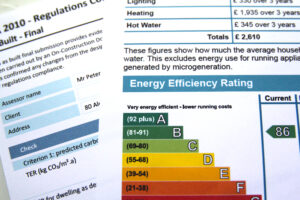SAP, SBEM, EPCs. These all come up as part of Building Regulations, but when do you need what?
You may be familiar with some common acronyms which appear around the building regulations process:
SAP – Standard Assessment Procedure
SBEM – Simplified Building Energy Model
DSM – Dynamic Simulation Model
EPC – Energy Performance Certificate
SAP, SBEM and DSMs are calculation tools used for calculating CO2 emissions for the purpose of compliance with Part L of the Building Regulations. They are also used to produce EPCs. Here we’ll look at why, and when you need these assessments carried out.
When do I need an EPC?
Buildings require an EPC when they are constructed, or are being sold or rented out. This only applies to buildings that use energy to condition the indoor climate (heating, mechanical ventilation or air conditioning). This does not include lighting, hot water or heating/cooling for industrial processes.
The term ‘constructed’ above can mean new build, or work to existing buildings.
EPCs for Dwellings
For dwellings, new dwellings created through a change of use require an EPC. Examples of this include conversion from offices into dwellings, or a house into flats.
EPCs for dwellings are produced through SAP or RdSAP (Reduced Data SAP) software. Newly created dwellings require a ‘SAP EPC’, whereas existing dwellings require a version created with RdSAP. SAP calculations are desk based, whereas RdSAP assessments are carried out through a site visit.
EPCs for Non Domestic Buildings
For non-domestic buildings, an EPC is required when an existing building is modified to have more or fewer parts than it initially had. A part is an area of the building that is designed to sold or rented by a separate occupant.
Non-dwellings require an EPC derived from the SBEM tool, or approved DSM tools. DSM gives a more accurate result and is required for buildings of level 5 complexity (such as buildings having an atrium or automatic blind control). DSMs can also be used for lower complexity levels if desired.
SBEM and DSM tools can be applied to both existing and new buildings, though existing buildings usually require a site visit for evidence gathering.
For buildings containing multiple non-domestic parts an EPC can usually be provided either for the whole building or for each separate part. The exception to this is that parts with their own independent heating system must have their own EPC, unless the building is being sold or rented as a whole.
EPCs are valid for 10 years or until a more recent EPC is carried out.
Do I Need SAP or SBEM?
SAP, SBEM and DSMs are also used for assessing and checking Building Regulations whenever a CO2 calculation is required.
New, conditioned dwellings and non-dwellings require compliance with a carbon target (Target Emission Rate) which is calculated through the appropriate modelling tool. This is to demonstrate compliance with Part L1A (for dwellings) and Part L2A (non-dwellings) of the Building Regulations.
The software tools also include checks for other aspects of Building Regulations such as limiting standards for fabric and building services, and overheating/solar gain compliance.
Existing Buildings
Large extensions to non-dwellings are to be regarded as a new building and they must meet the carbon and other L2A requirements. A large extension is deemed to have a total useful floor area of at least 100 m2 and is greater than 25% of the total useful floor area of the existing building. New-build dwellings attached to an existing building are also still treated as new build and must comply with L1A.
Compliance with Building Regulations (L1B for dwellings and L2B for non-dwellings) for work on other existing buildings just requires meeting minimum standards for opening areas, fabric and services.
However, you don’t have to meet every standard if you can show that the additional CO2 created is compensated for elsewhere. This would need to be shown with a CO2 calculation through the relevant tool. A common one for this is when extensions to dwellings exceed the 25% opening rule.
Are any buildings exempt?
Certain buildings are exempt from EPCs and Part L of the Building Regulations:
• Buildings used as places of worship and for religious activities
• Temporary buildings with a planned time of use of two years of less
• Residential buildings which are intended to be used less than four months of the year or where the owner or landlord could reasonably expect the energy consumption of the building to be less than 25% of all year-round use.
• Stand-alone buildings with a total useful floor area of less than 50 m2 (i.e. buildings entirely detached from any building)
• Buildings proposed for demolition
Holiday accommodation does not need an EPC if it is rented out for less than 4 months a year or is let under a licence to occupy.
Protected buildings (due to environmental designation or special architectural or historical merit) are exempt from Part L requirements if compliance with them would ‘unacceptably alter the character or appearance of the building’. They may also be exempt from EPCs, however the guidance isn’t entirely clear on this.
For more information on Part L of the Building Regulations, see the approved documents Planning Portal Documents.
For more information on EPCs, see this guide for dwellings and this guide for non-dwellings.
If we can help further just get in touch on 0330 055 34 05 , or email us at be@buildenergy.co.uk
